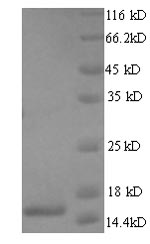Intact human T cell receptor alpha constant (TRAC) cDNA (1-142aa) with an N-terminal 6xHis-tag was expressed in the yeast. The forming protein is the recombinant full-length human TRAC protein. The purity of this protein is greater than 90% determined by SDS-PAGE. Under reducing conditions, the gel showed a molecular weight band of about 16 kDa. This recombinant TRAC protein can be used as the immunogen for antibody synthesis. Besides, it also may be applied in the studies of TRAC-related immunology.
The extracellular region of αβ T cell receptors (TCRs) is made up of an α chain and a β chain, each containing Ig-like variable and constant domains. TRAC, the TCR Cα domain, is significant in differing from the classical IgC1 domain. Substantial evidence indicated that TRAC interfaces with CD3. Mutagenesis has demonstrated that the interactions of CD3δɛ and CD3γɛ subunits with the TcR Cα and Cβ domains, respectively, contribute to the stability and function of the TCR–CD3 signaling complex. Gijs I. van Boxel etc. concluded that the TCR Cα domain can also adopt two very different stable conformations, a fundamental property that is potentially central to TCR function and that the TCR Cα domain may facilitate the "β-strand slippage."




